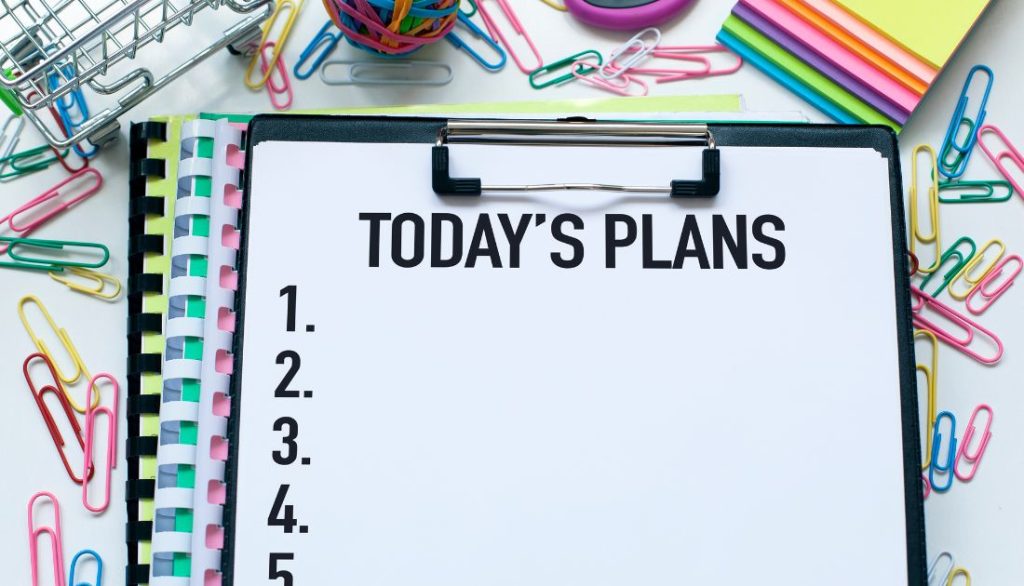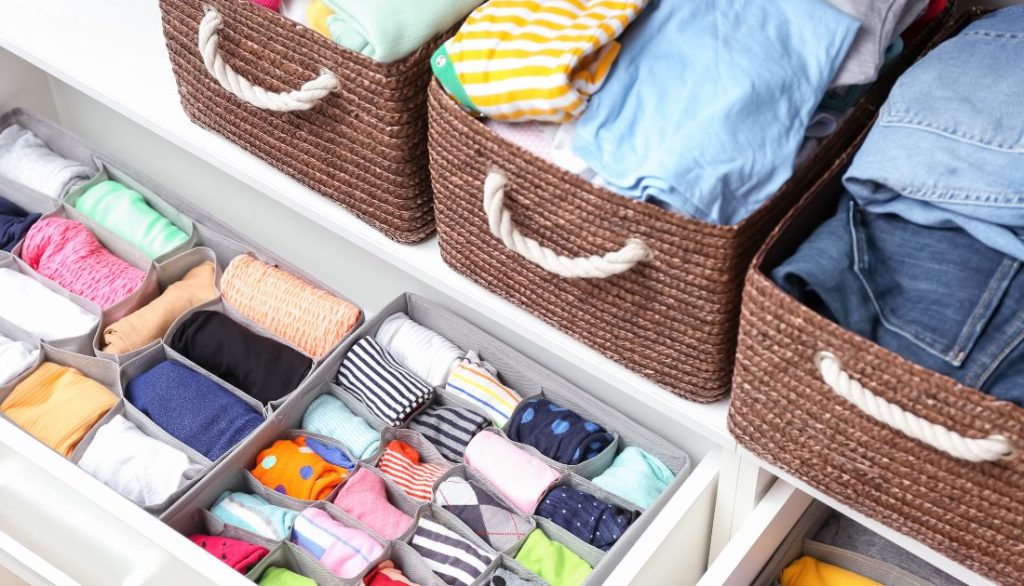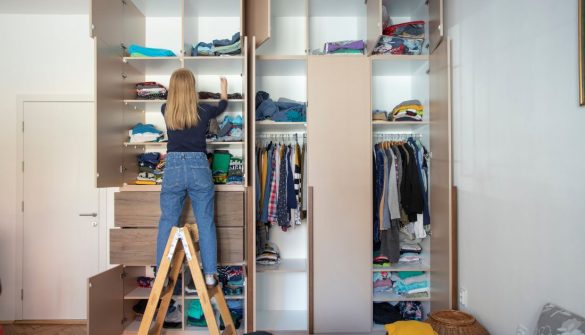Table of Contents
In our busy world, we often have a lot of stuff and worries filling up our lives. One place where things can get really messy is our closets. When our closets are messy, it can make us feel stressed and overwhelmed. But if you start cleaning up your closet, you’ll not only make room for your things but also clear up your mind.
Have you ever felt stressed when looking at your messy closet? Clothes everywhere, like a big jungle of chaos? If you have, you’re not alone. Sometimes, how messy our stuff is reflects how chaotic our thoughts feel.
A messy closet can add to the stress in our lives. But don’t worry. Cleaning out your closet is about more than organizing your clothes. It’s also about making your mind feel clearer and more peaceful.
Picture waking up each morning to a nicely organized closet. Everything has its spot, colors match nicely, and only clothes that make you happy are there. This isn’t just a fantasy. It can happen if you decide to make it real.
Schedule Your Decluttering Session
Set Your Intentions
Before starting your decluttering session, take a few moments to set your intentions.
Ask yourself why you want to clear out your closet and how you hope to feel after completing the process.
Setting clear intentions can help motivate you and keep you focused throughout the decluttering process.
Define Your Personal Style
As you go through your closet, consider what truly reflects your style and what no longer serves you.
Keep pieces that make you feel confident and comfortable while letting go of items that no longer align with who you are now.
Defining your style will make curating a wardrobe that truly represents you easier.
Dedicate Time to Your Busy Schedule
Finding time for decluttering in a busy schedule can be challenging, but setting aside time for this task is crucial.
Whether it’s 30 minutes every day or a few hours on the weekend, scheduling regular decluttering sessions will help ensure consistent progress.
Remember, even small increments of time can add up to significant changes in your space.

Empty Your Closet
- Start by taking everything out of your closet.
- Sort items into categories like keep, donate, and toss.
- Be ruthless – if you last wore it a year ago, let it go.
- Consider keeping only pieces that bring joy or are essential to your wardrobe.
Organize Like Items Together
- Once you’ve pared down your wardrobe, organize similar items together.
- Use storage solutions like bins or hangers to keep things tidy.
- Having a place for everything will make it easier to maintain order in the long run.
By clearing out clutter and creating a streamlined closet, you’ll not only free up physical space but also mental space for a more peaceful mind.
Thoroughly Clean Your Closet
- Empty it Out: Start by taking everything out of your closet. This allows you to see what you have and evaluate each item individually.
- Sort and Declutter: Separate your clothes into piles: keep, donate, and toss. Be honest with yourself about what you need and what can go.
- Organize Efficiently: Once you’ve narrowed your wardrobe, organize items by category (e.g., tops, bottoms) or color for easy access. Use storage bins or shelves to maximize space.
Begin Sorting Your Clothes
When clearing out your closet, begin sorting your clothes into three main categories: keep, donate/sell, and discard.
- Keep: These are items you wear regularly and love.
- Donate/Sell: Clothes that no longer fit or serve a purpose for you can be given away or sold.
- Discard: Items that are worn out beyond repair should be thrown away.
Assess each item in your closet to see whether it fits into these categories. Be honest about what you truly need and what takes up space.
Remember, decluttering is not just about getting rid of things. It’s also about making room for the things that most matter to you.

Refine Your Piles
Resell: To make some extra cash, consider selling any quality items that you no longer need or use online through platforms like eBay or Poshmark.
Donate: If an item is still in good condition but no longer serves a purpose for you, consider donating it to a local charity or thrift store.
Repair: Evaluate if any damaged items can be easily fixed and decide whether it’s worth investing the time and money into repairing them.
Discard (responsibly): Recycle or properly dispose of any items that are beyond repair or donation in an environmentally friendly manner.
Bonus Pile: Maybes
Decide a timeframe for revisiting your “Maybes” pile to determine if you need those items. If not, consider adding them to the resell, donate, or discard piles.
Stow Away Out-of-season Apparel
Keep your closet organized by stowing away out-of-season apparel in bins or garment bags when unused. This will free up space for the current season’s clothing and make it easier to find what you need.
Free Up Space
Slim velvet hangers are a great way to maximize closet space, as they take up less room than traditional hangers. They also prevent clothes from slipping off, keeping your wardrobe organized and tidy.
Multi-purpose woven baskets are perfect for storing accessories like scarves, belts, and hats. They add a touch of style to your closet while keeping small items contained and easy to find.
Sock and underwear organizers make it simple to keep these smaller items in order without taking up too much space. With compartments for each pair, you can easily grab what you need without rummaging through drawers.
Boot shapers maintain the shape of your boots when not in use, preventing creases and extending their lifespan.
Bag pillow inserts help handbags keep their structure while stored away on shelves or cabinets.
Shelf dividers create designated sections within your closet for different categories of clothing or accessories, making it easier to maintain an organized space overall.
Organize and Put Clothes Back
Sort through your clothes: Start by removing all the items from your closet. Divide them into piles based on what to keep, donate, or throw away.
Organize by category: Group similar items together for easy access. Hang dresses together, pants in one section, shirts in another.
Utilize storage solutions: To maximize space and keep things tidy, consider using bins, baskets, or shelf dividers. Hang scarves on hooks or store shoes in clear containers for visibility.
Maintain order: After organizing everything, commit to putting clothes back where they belong after each use. This simple habit will help prevent clutter from building up again.
By following these steps and staying consistent with maintaining your newly organized closet space, you can create a calming environment that promotes clarity of mind and reduces stress in your daily routine.

FOLDING TECHNIQUE
Start by laying your garment flat on a clean surface.
Smooth out any wrinkles or creases to ensure a crisp fold.
Fold the item in half, making sure the edges line up perfectly.
For tops, fold sleeves towards the back before proceeding with the next fold.
Continue folding until you have a compact rectangle or square shape.
By perfecting your folding technique, you can maximize space in your closet and keep your clothes looking neat and organized at all times. This simple but effective process will save you time when getting dressed and contribute to maintaining a clutter-free environment that promotes peace of mind and mental clarity.
FAQs
Why is cleaning out closet important for mental well-being?
- Reduces Stress: Clutter in our physical surroundings can lead to clutter in the mind, causing feelings of overwhelm and anxiety. By decluttering our living spaces, we create a sense of order and organization that can help reduce stress levels.
- Enhances Focus: A clutter-free environment improves concentration and cognitive function. When our space is clean and tidy, it’s easier to focus on tasks without distractions from unnecessary items.
- Promotes Positive Emotions: Removing clutter can evoke a sense of accomplishment and satisfaction, boosting overall mood and mental well-being. It creates room for positivity to flourish in both our environment and mindset.
How do I know if my closet needs decluttering?
Overflowing shelves: If your closet shelves are packed so tight that you can barely slide one more item onto them, it’s time to declutter. A cluttered space can make finding items difficult and lead to clothes getting crushed and wrinkled.
Unworn items: Look in your closet and notice the pieces you haven’t worn in months or even years. If certain items no longer fit your style or lifestyle, it might be best to part with them.
Lack of organization: Do you spend extra time searching for pieces in the morning because everything is jumbled together? Lack of organization in your closet can cause stress and waste valuable time. It may be time to declutter and reorganize for a more efficient space.
What are the benefits of embarking on a closet makeover journey?
Less stress: A cluttered closet can lead to feelings of overwhelm and anxiety. By decluttering and organizing your space, you’ll create a more peaceful environment that can help reduce stress levels.
Increased productivity: When everything in your closet has its place, getting ready in the morning becomes faster and easier. You’ll no longer waste time searching for items or trying on multiple outfits before finding the right one.
Boosted confidence: A well-organized closet filled with clothes that make you feel good can boost your self-esteem. Knowing what you must wear and feeling confident in your outfit choices can set a positive tone for the day ahead.
How can I overcome emotional attachments to items in my closet?
Identify the Emotional Attachment: Start by pinpointing why certain items in your closet hold emotional significance for you. Understanding the root of your attachment is crucial, whether it’s a sentimental gift, a reminder of a special occasion, or simply because it makes you feel a certain way.
Practice Mindfulness: When sorting through your closet, take a moment to pause and reflect on why you are holding onto each item. Ask yourself if keeping it aligns with your current lifestyle and future goals. Being mindful can help you break free from attachments that no longer serve you.
Shift Your Focus: Instead of focusing on the emotional attachment to an item, redirect your attention towards the benefits of letting go – decluttering for mental clarity, creating space for new opportunities, and simplifying your life. Remember that memories live within us, not within our possessions.
What should I do with items I decide to discard or donate?
Discarding Items: For items you no longer need or want, consider recycling, reusing, or properly disposing of them. Recycling clothing and textiles can help reduce waste in landfills. Donating gently used items to local charities or thrift stores is also a great way to give back to the community.
Donating Items: When donating items, ensure they are clean and in good condition. Local shelters, organizations supporting those in need, and donation centers often need clothing donations. Remember that what you may not find useful anymore could greatly benefit someone else.
Consignment & Resale: If your discarded items still hold value but no longer fit your lifestyle, consider selling them at consignment shops or online resale platforms. This way, you can make some money while decluttering your closet effectively.
